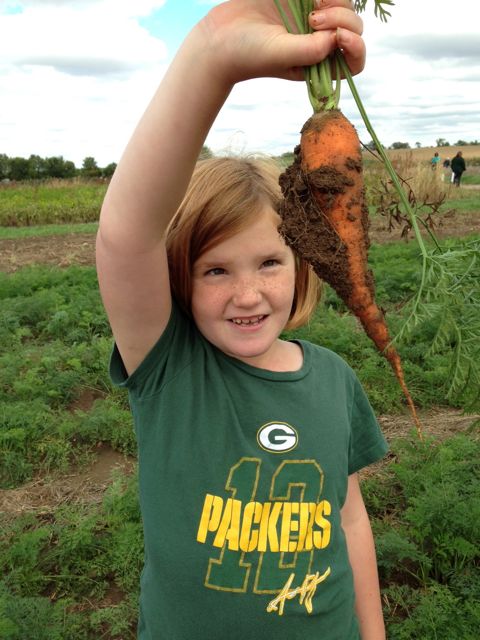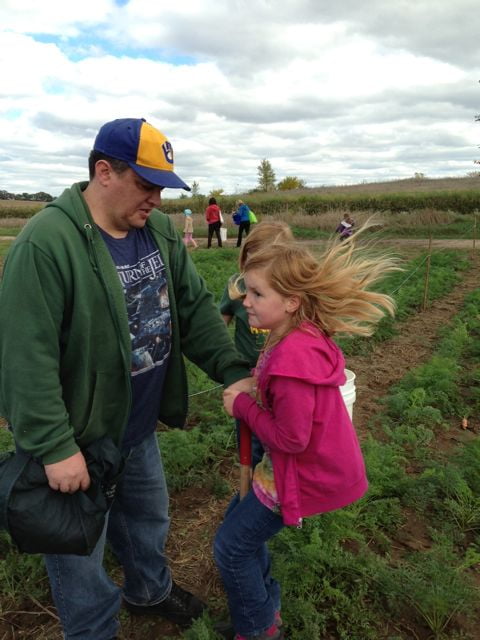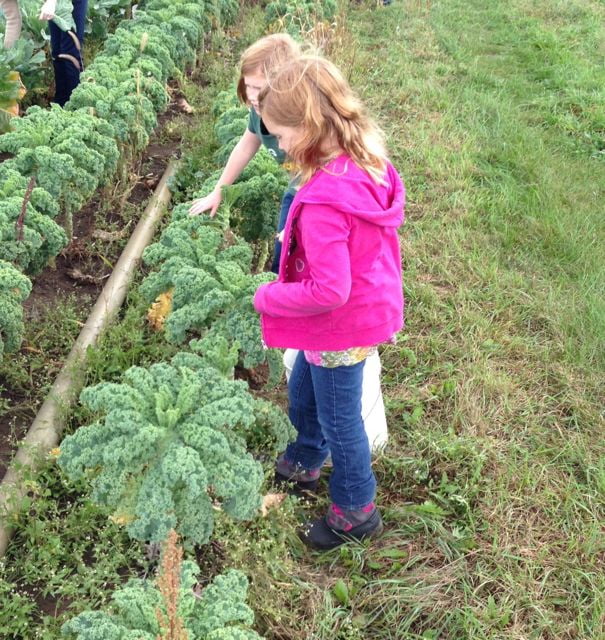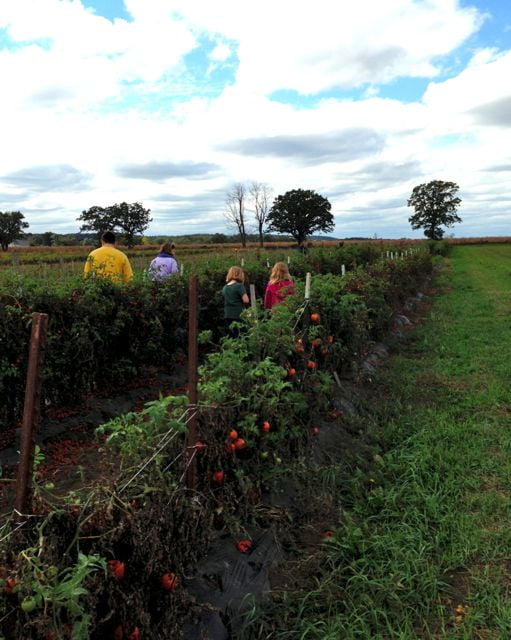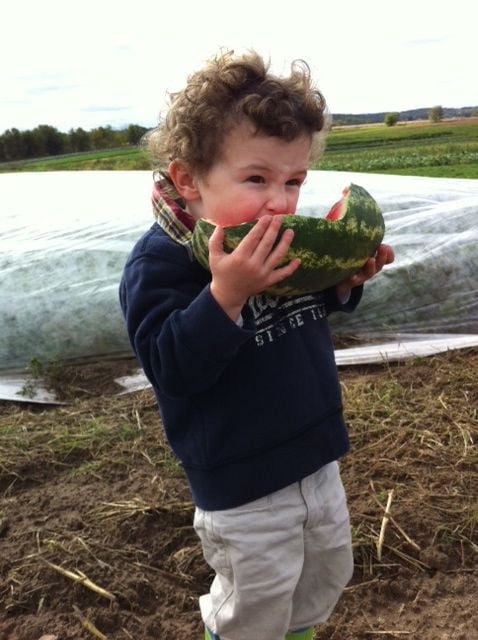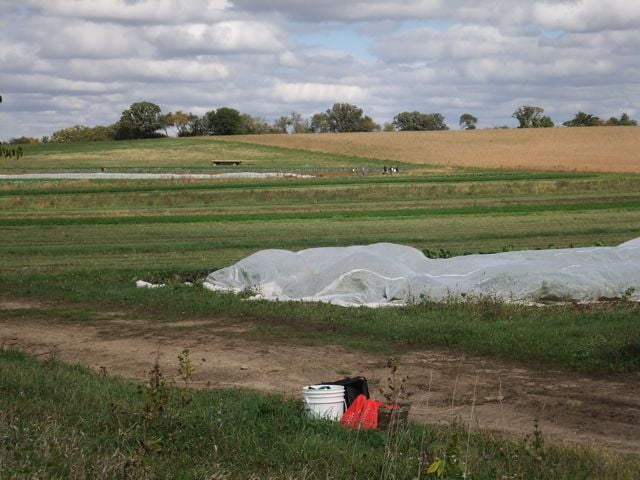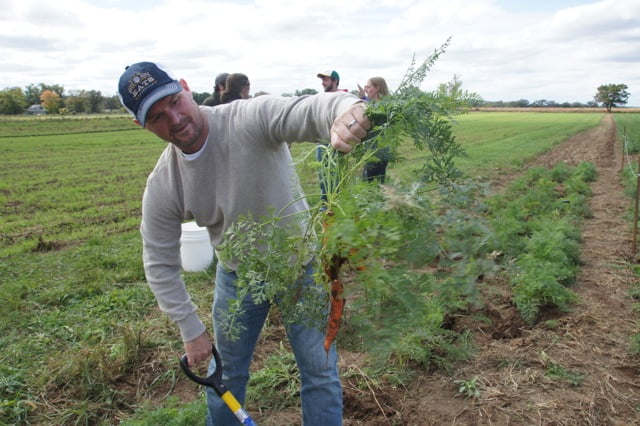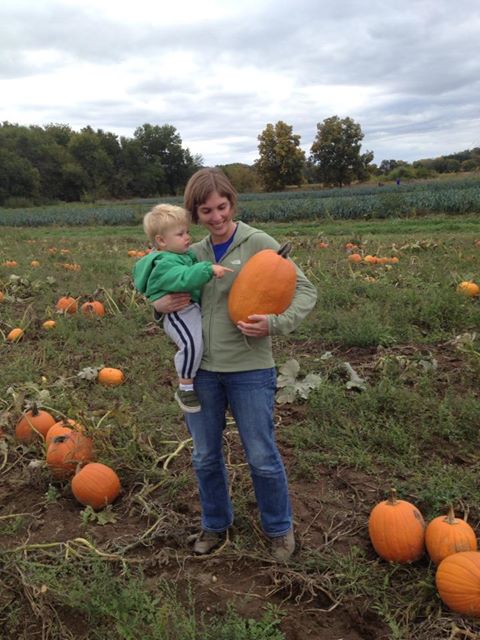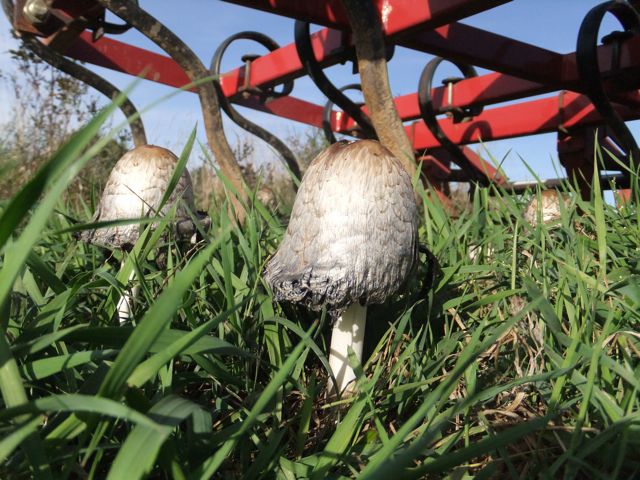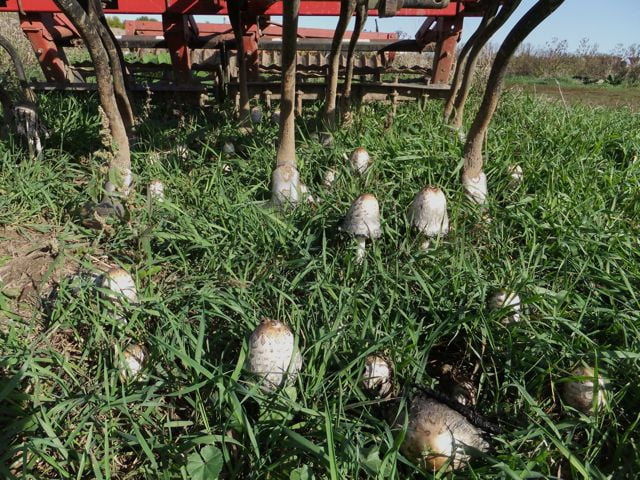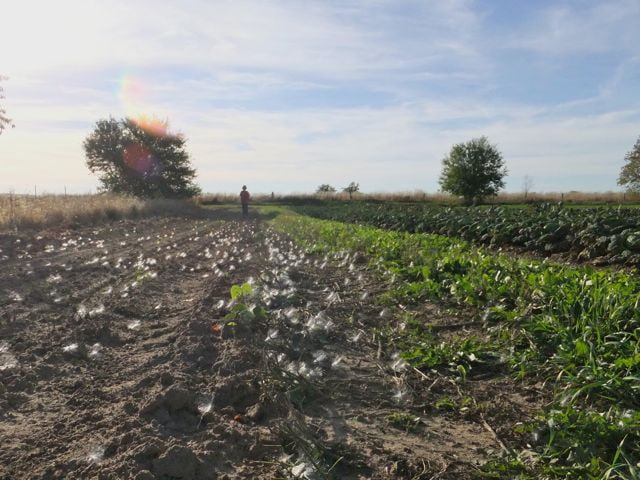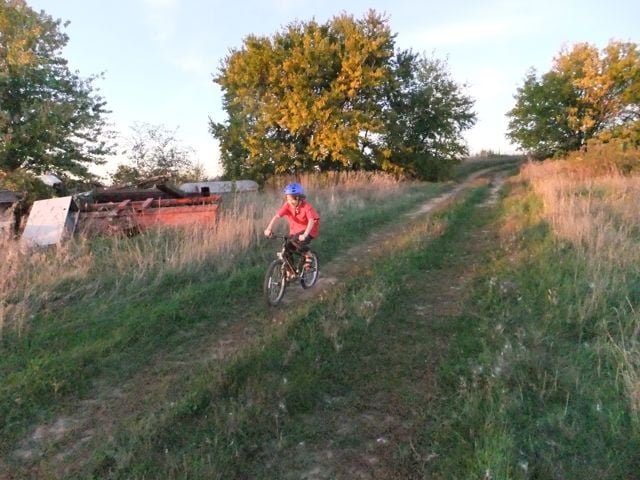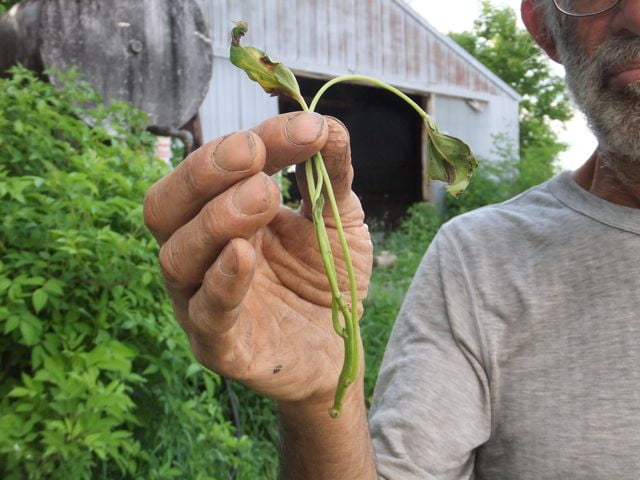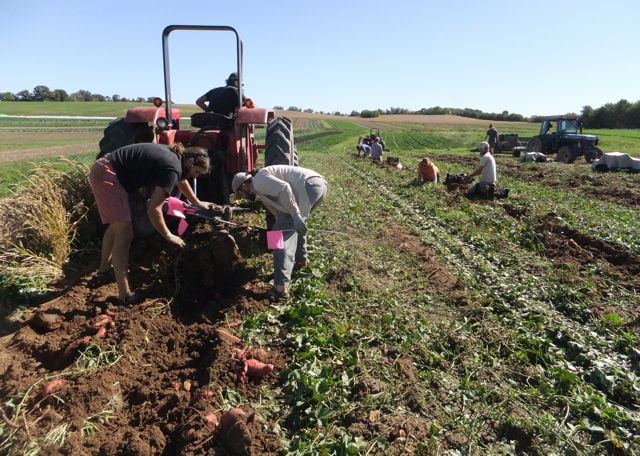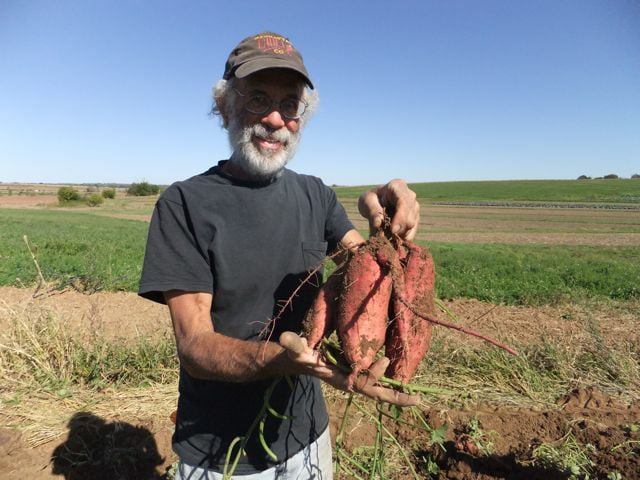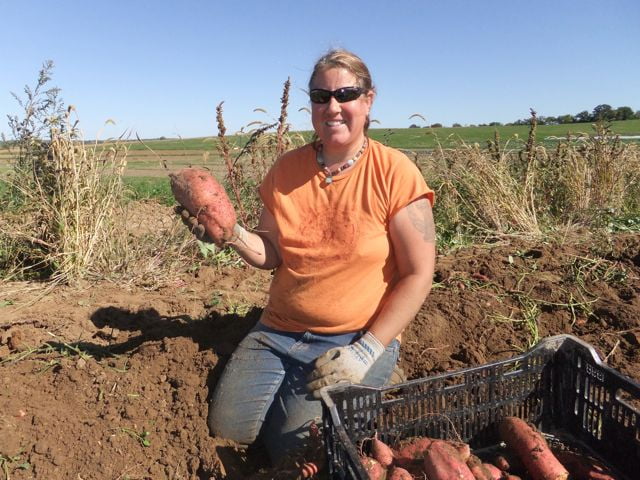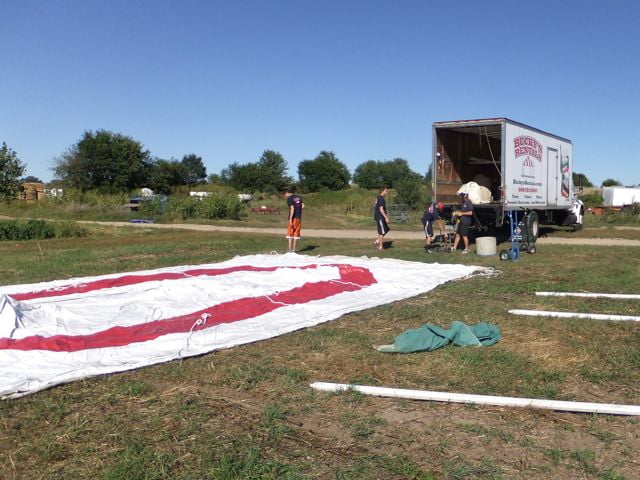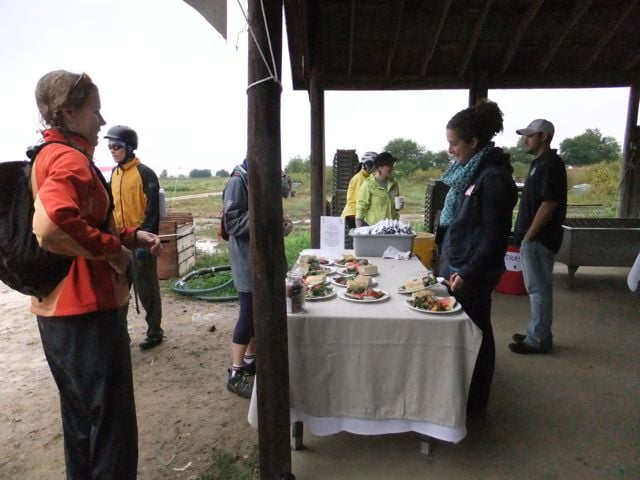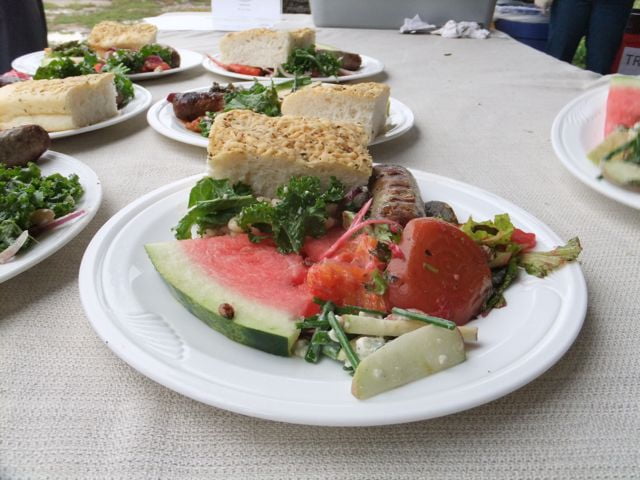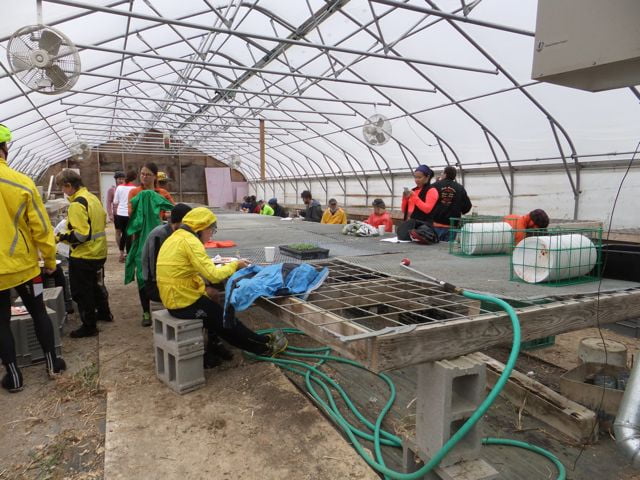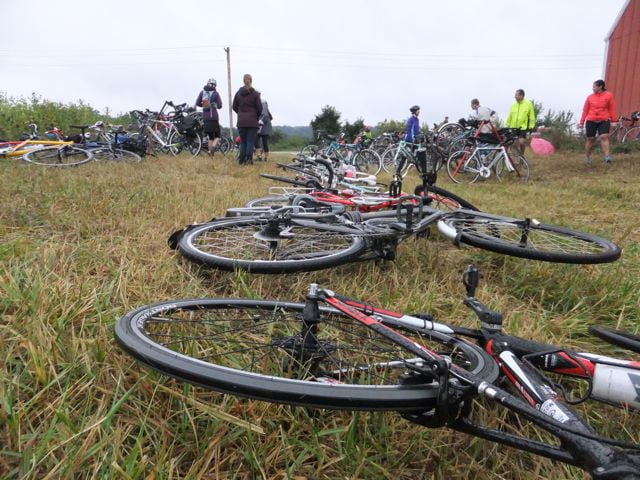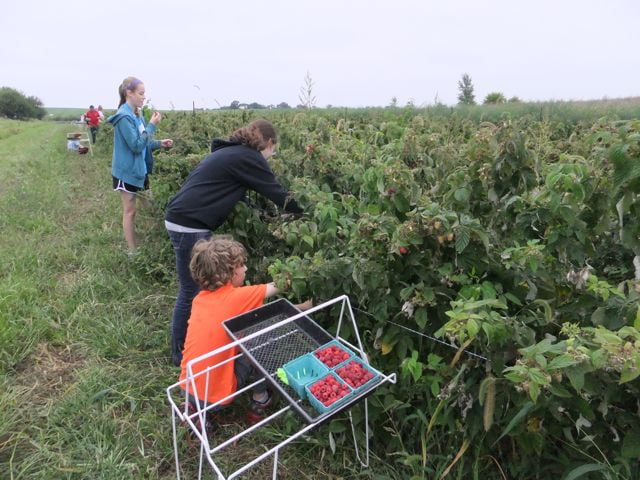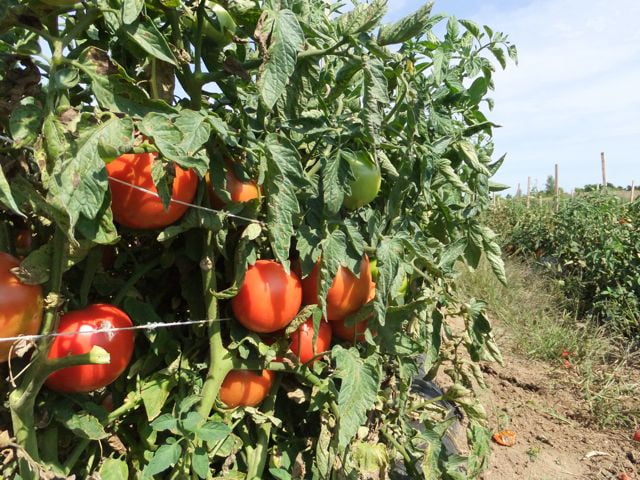Blog
URGENT: Please comment on the food safety act
- On: November 06, 2013
 0
0
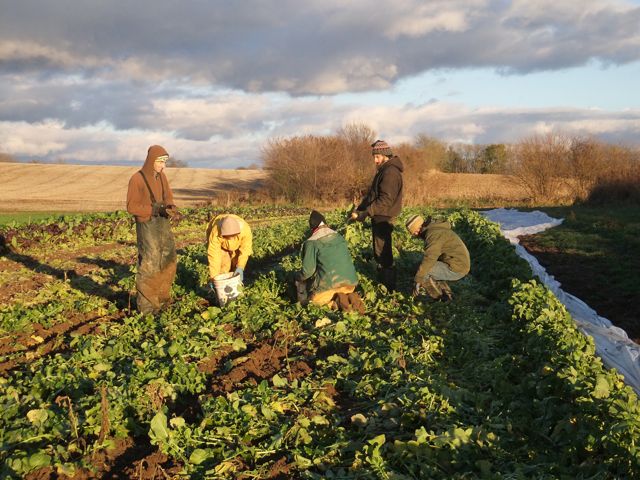
The crew harvests winter radishes. It was too muddy to use our mechanical root harvester, plus we find that harvesting by hand is easier on the brittle radishes. From left, Jon, Kelty, Alex, Clint, and Kyle.
Purple EOW members, this is your final delivery (November 7/8).
Weekly and green EOW members, you will receive your final box next week (November 14/15)
Wrap-up for purple EOW members. Thank you for being members of our farm this year! We hope you have enjoyed the experience. A few thoughts:
– Please read next week’s email for our annual survey. We will incorporate your comments into our plans for next year.
– Please return all your empty CSA boxes.
– We expect to open 2014 registration soon for returning Tipi members. Watch for emails from us.
Please comment on the Food Safety Modernization Act
The Food Safety Modernization Act (FSMA) is a piece of legislation currently under review by the Food and Drug Administration. It is an intimidating set of regulations that seek to overhaul food safety in the USA. There are sound ideas in the act, such as protecting fresh produce from exposure to raw manure. Unfortunately, this complex piece of legislation has enough bad ideas to drive many small and medium vegetable farms out of business. As summarized by the Michael Fields Agricultural Institute, “The (FDA)’s first draft of new safety rules has big problems. They will be costly, especially for smaller farmers. They conflict with National Organic Program rules and undermine conservation practices. They undercut CSAs and other essential markets in local food systems. What is bad for our farmers is bad for our consumers.”
Will it put us out of business? No, but it will make our job much more difficult, without improving the quality of your food.
The National Sustainable Agriculture Coalition (NSAC) has done a good job summarizing the current draft of the legislation. Go to the NSAC website to learn more about the Food Safety Act, and to read their assessment of the top problems with the proposed regulations.
The FDA is accepting comments on the FSMA until November 15. If you are concerned about maintaining your community of local farms, we encourage you to submit a comment to the FDA.
The Sustainable Ag Coalition has a good instructions on how to submit an effective comment, as well as links to the government submissions pages. We encourage you to submit your comment under both the Produce Rule and the Preventative Controls Rule. Our farm and CSA (and your food supply) will be affected by both pieces of legislation. Beth
Steve’s take on the Food Safety Modernization Act.
We don’t often talk with you about the cultural and political pressures that affect us as organic famers. Something is brewing that we want you to know about. The U.S. Food and Drug Administration (FDA) is putting together an administrative rule called the Food Safety Modernization Act (FSMA). Congress authorized this act, intending to improve the safety of the American food supply.
The FSMA, as currently drafted, would have a huge negative effect on our farm and other similar small and medium-sized vegetable farms, whether organic or conventional. The food safety rules call for extreme preventative measures that have not been shown to reduce foodborne illness. The FDA expects that compliance would cost a farm like Tipi about $30,000 per year. Smaller, younger farms could spend half their net income meeting these standards, forcing them out of business.
The whole draft rule is over 3,000 pages. I have not read all of it, but have gone through a few especially relevant topics. I’m relying on small farm and sustainable ag advocates who have digested and summarized this sprawling document.
The FSMA, as written in draft, is a true threat to the locally-oriented organic farms that feed you through CSAs, food coops, farmers’ markets and farm-to-school programs. See above for links to some well-researched information.
The FDA is taking comments on the FSMA rules through next Friday November 15. We ask you to help stop this damaging regulation by sending a short comment to the FDA. You don’t need to be overly technical. A comment like the one below (in your own words of course) would register your opinion:
“We are CSA members in Wisconsin and our family (or household) eats more fresh produce because of our CSA commitment. Do not put burdensome, unproven mandates on our farmers! We trust their food and their judgement. Your proposed FSMA rules would damage the local farms that we depend on for safe, high-quality food.”
Thank you for your time considering this. Steve
Veggie List and Veggie Notes (week #25, purple EOW)
Tip for cutting winter squash: If you want to peel or dice your butternut squash, microwave the intact squash on high for one minute. That’s enough to warm and soften the squash, making it much easier to peel. I find this trick useful even when just cutting the butternut in half.
Russet potatoes, about 3.5 lb
Sweet potatoes (unwashed), about 2 lb
Butternut winter squash
Collard greens
Leeks, about 1.5 lb
Carrots, 2 lb
Beauty Heart radish, 1 lb, about 2
Onion, 1
Broccoli, 1 modest head or some side shoots
Next week’s box will probably contain green cabbage, butternut squash, sweet potatoes, beets, celeriac, carrots, onions and Brussels sprouts.
Russet potatoes – Chris Malek sent us big beautiful russets this week, perfect for baking.
Sweet potatoes – These are unwashed. Sweet potatoes need warm storage. It is too risky to wash them this time of year without a warm place to dry them, so we ran them through a dry brusher to knock off most of the dirt. This delivery is mostly the Beauregard variety. Here are a few things we’ve learned about sweet potatoes:
– Store your sweet potatoes at room temperature. They suffer chilling injury below 50 F.
– The sweet potatoes we grow require slightly longer cooking than ones from the supermarket, perhaps because they contain higher moisture so soon after harvest. Cook thoroughly for best flavor and texture.
– Sweet potatoes are good at any size. We have cooked everything from tiny to jumbo and consistently find that all sizes taste good.
– We have a new favorite way to roast sweet potatoes. We used to prepare sweet potato fries. Now we just quarter the potatoes, rub with olive oil, dust with salt and place cut-side-down on a cookie sheet. Roast in a 450 F oven without turning until soft. The flavors will caramelize (like sweet potato fries) but preparation is simpler and the cooking time less exacting. Slender sweet potato fries go from undercooked to overcooked in the blink of an eye.
Butternut winter squash – Almost everyone will receive the JWS6823 variety. We tried several new winter squash varieties this year. This one did quite well and has good flavor. This variety produces small squash, about the same size as the Metro we sent a few weeks ago.
Collard greens – These end-of-season collards need more extended cooking than tender spring-grown collards. They can handle long braising or simmering. Remove the midveins before cooking.
Beauty Heart radish (round, white and pale green exterior, bright pink interior) – The interior color is lovely. Slice thinly and add to salads, cook lightly in mixed vegetable medleys or cut into matchsticks and add to pasta salads. We enjoy grated carrot and Beauty Heart salads all winter.
Heads down
- On: October 30, 2013
 0
0
We are pushing hard to gather our storage crops while the weather is still mild. That’s all Steve and I have to report. Beth
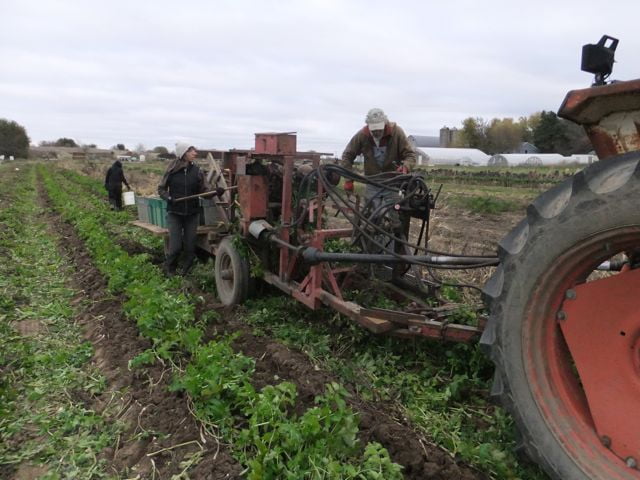
Steve steers our root harvester during parsnip harvest. Kerry keeps the machine clear of leaves.
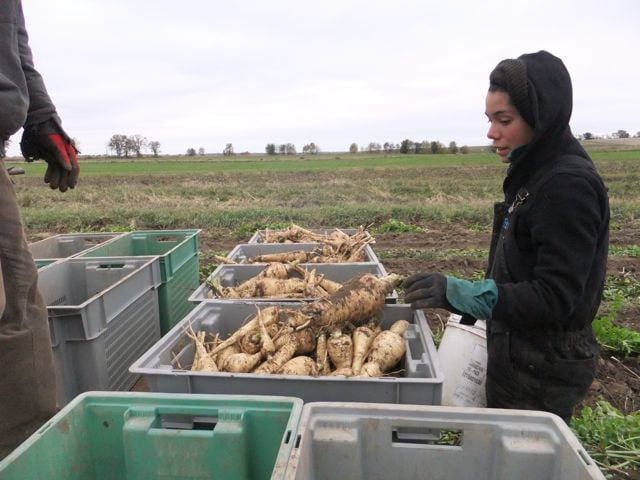
The parsnips are particularly nice this year. Boi helps harvest.
There are two more CSA deliveries after this week.
October 31/Nov. 1 (this week) = green EOW
November 7/8 = Final box for purple EOW members..
November 14/15 = Final box for weekly and green EOW members.
Our winter share deliveries start soon thereafter. I emailed the schedule directly to members registered for those shares. Our winter shares are all sold out.
Veggie List and Veggie Notes (week#24, green EOW)
Pak choy, 1 head
Carrots, 2 lb
Parsnips, about 1.5 lb
Sweet Italian frying peppers, mixed green & red, about 5
Daikon radish, about 1 lb
Yellow onions, 2
Garlic
Parsley, 1 bunch
Winter squash AND/OR Romanesco broccoli
Next week’s box will probably contain russet potatoes, leeks, butternut squash, sweet potatoes, collard greens, carrots, Beauty Heart radish and more.
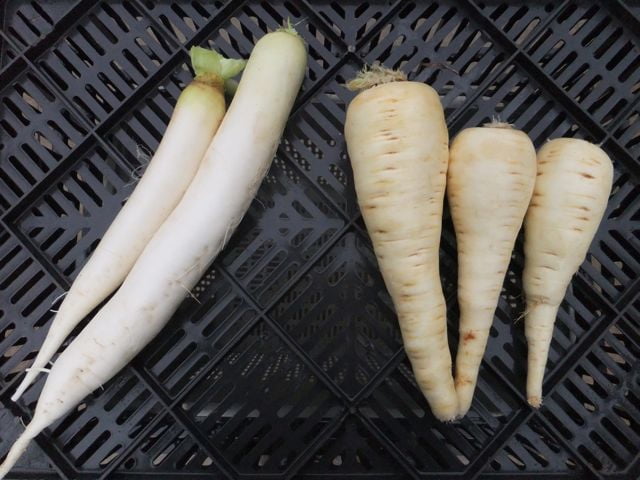
Daikon radish (slender white roots, at left in photo) – These radishes are good cooked or raw. Grated daikon is a nice addition to salads. We often make a salad of grated carrots and radishes, with Asian-style dressing (rice vinegar, mirin, sesame oil, soy sauce, minced garlic).
Parsnips (tapered cream-colored roots, at right in photo) – Those long, white roots are not carrots, they are parsnips. The two vegetables are related. When cooked, parsnips are sweet and starchy. For the best flavor, brown them to caramelize the sugars. Here are a few ideas for parsnip preparation:
– Caramelize the parsnips by roasting them in a vegetable medley.
– Parsnip fries are delicious: cut like French fries, coat very lightly with oil, place on a cookie sheet and roast in a hot oven until brown and cooked through.
– Try substituting grated parsnips in a potato pancake recipe. They brown beautifully and are very tasty.
– Steve loves pan-fried parsnips with onions and garlic.
Pak choy (large head with green stems & leaves) – Looks like bok choy, acts like bok choy.
Italian frying peppers – We’ve held these peppers in storage so please use them quickly. These are sweet peppers, not hot.
Garlic – The heads are quite small. As I explained previously, the garlic crop was terrible across the Midwest. These small heads are our last garlic for the season. Our garlic grower John Hendrickson needs to replant all the remaining large and medium heads for next year’s crop.
Winter squash – Some members will receive winter squash, some will get Romanesco instead. Some will receive colorful Carnival or Celebration squash. See photo below. These are acorn hybrids. The coloring resembles Sweet Dumpling or delicata but the flavor is mild, reflecting their acorn parentage. A few members will receive Sugar Dumpling (not shown in photo; yellow/green striped with smooth shoulder at the stem). These are are smaller and taste like Sweet Dumplings. They resemble the front left squash in the photo.
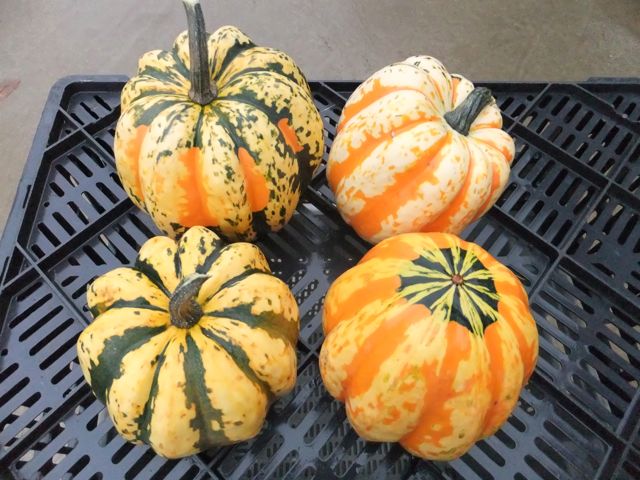
Carnival squash at left, Celebration squash at right.
Is it over yet? No, not yet …
- On: October 22, 2013
 0
0
There are three more deliveries after this week.
October 24/25 (this week) – purple EOW
October 31/Nov. 1 – green EOW
November 7/8 – Purple EOW members get their final box.
November 14/15 – Weekly and green EOW members get their final box.
Farm News: Freeze
It froze hard every night this week, 25 – 26 F. This is not unusual for late October but we were working in shorts just last week. We still have many fall and winter storage crops to harvest. Beets, carrots, leeks, Brussels sprouts, and greens can handle a string of cold nights. Cabbage is more sensitive so we put 40,000 lb into storage this week, enough to last through St. Patrick’s Day in March. Next up on our harvest list: beets, celeriac, and winter radishes. These storage crops are very important to our business. Almost 20% of our yearly sales happen after mid-November, mostly as sales to our store customers.
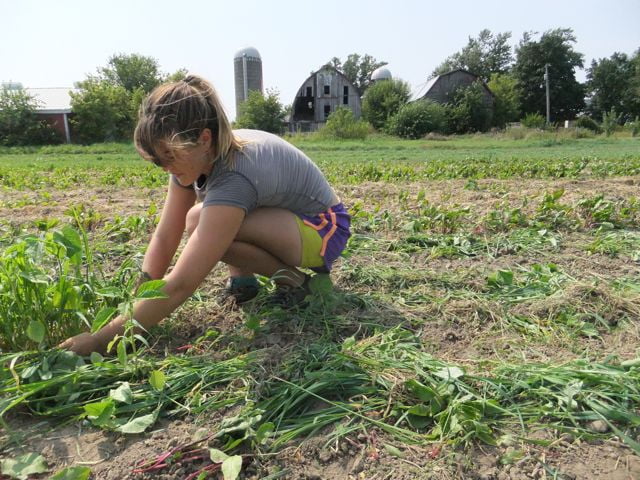
Above, Bri rescues beet seedlings in mid-August. The weeds were enormous. We considered abandoning the planting but did not want to sacrifice the beets.
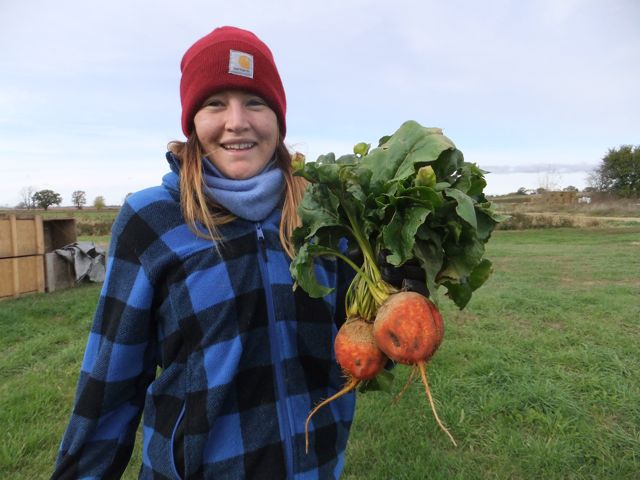
Now two months have passed and we just harvested those beets for your CSA box this week. The extra effort paid off. Above, Bri holds a cluster of golden beets.
One more u-pick photo and comment
Member Robin Schmoldt sent the photo above from our Oct 6 u-pick, and wrote to tell us about her family’s experience that day.
“This year, (our daughter) Emma was ready to go to the farm. She had an absolute blast. For us, it was wonderful to have a chance to start teaching her where good food comes from. For her, it was amazing to see a real farm and not just illustrations in her books. Thank you so, so much for providing this opportunity. Emma’s only two, so she’s still new to this forming-lasting-memories thing, but a week after her visit she would tell everyone she saw about how she “picked broccoli and ‘tee-matos’ and carrots and pumpkins”, so your farm obviously made quite the impression. Thank you again!”
That’s exactly how we hope children will experience our farm events. Sometimes Steve and I get so wrapped up in the planning details (tornado protocol! no dogs!) that we neglect to emphasize the joy of visiting the farm where your food is grown. It can be a great experience at any age. Thank you to all who visited and sent their photos and impressions. We’ve enjoyed your comments so much. Beth
Veggie List and Veggie Notes (week#23, purple EOW)
The broccoli is amazingly productive this year. We planted the usual amount but somehow ended up with much more broccoli than usual.
Red cabbage
Golden OR red beets, 2 lb
Carrots, 2 lb
Leeks, about 1.5 lb
Onion, 1
Broccoli OR Romanesco broccoli, 1 or 2 heads
Bell peppers, 3 or 4
Poblano peppers, 3 or 4
Winter squash, 1 or 2, see note below
Next week’s box will probably contain carrots, parsnips, peppers, garlic and more.
Poblano peppers (triangular, shiny, red or dark green) – These hot peppers have great flavor, especially when roasted.
Bell peppers – We harvested these peppers before the frost. They are mostly red peppers, with a few green, yellow and orange mixed in. We have some Italian frying peppers stashed away for next week’s box. That will be the end of the peppers.
Winter squash – We have many different types of squash to distribute this week. You will receive one or two squash from this list. All types need to be eaten soon. They are all ‘short-season’ types that will not store for long. Store at room temperature with good air circulation, eg on your kitchen counter where you can keep an eye on them.
- delicata (long, slender, striped green and yellow) OR
- Sweet Dumpling (round, striped yellow/green, recessed stem) OR
- Sugar Dumpling (round, striped yellow/green, smooth shoulder at the stem) OR
- acorn squash (round, dark green) OR
- pie pumpkin (looks like a small, solid pumpkin)
Remaining schedule; u-pick photos
- On: October 16, 2013
 0
0
There are four more deliveries after this week.
Here is the schedule for our final deliveries.
October 24/25 – purple EOW
October 31/Nov. 1 – green EOW
November 7/8 – Purple EOW members get their final box.
November 14/15 – Weekly and green EOW members get their final box.
Last chance for 2013 receipt
Still need a 2013 receipt? Please follow the instructions below this week. I need to get the website updated for our 2014 season.
– Go to http://tipiproduce.csasignup.com/members/statusemail .
– Enter the email address you’ve given us for your CSA membership.
– You will promptly receive a receipt via email.
Virtual tour of our pumpkin/gleaning u-pick
The lovely photos below were taken by members during our October 6 u-pick. They capture the enthusiasm of the day. I couldn’t include everyone’s photos so I’ve chosen a selection to highlight different parts of the u-pick. This u-pick is the most in-depth way to experience our farm. Members wander the fields and dig into individual crops. The first four photos are from Sara Dyer. Can you see how engaged her children are?
The photo below is from Shelly Duffield. I saw Shelly and her son at the end of the u-pick and asked why his clothes were soaked. He ate the entire melon.
The watermelon field is the furthest from the buildings. See the people in the distance near the neighbor’s soybean field? That’s how far Shelly and her family walked to get their melon.
White row cover billows in the foreground. We covered that field of greens and radishes to speed their growth.
Michelle Mize sent the next two wonderful photos.
Finally, Rebecca Paulson sent the photo below and wrote “I liked this photo of me and my two pumpkins -though I might be biased.”
Veggie List and Veggie Notes (week #22, green EOW)
Butternut winter squash, 1
Satina yellow potatoes, 3.5 lb
Yukina greens
Italian beans, 1.5 lb
Yellow onions, about 2
Broccoli (almost everyone) OR Romanesco broccoli (Vilas only)
Scallions, 1 bunch
Italian frying peppers, mixed colors
Next week’s box will probably contain winter squash, cabbage, Italian beans, carrots, peppers and more.
Butternut winter squash – Our first butternuts are cured and ready to eat. This is a variety called ‘Metro’ that cures quickly.
Satina potatoes – These pale yellow potatoes are from Chris Malek of Malek Family Stewardship Farm.
Yukina greens – This relative of mustard greens is my favorite fall cooking green (although it is pretty tasty raw too). Both stems and leaves are edible. They reduce substantially when cooked. I stir-fry lots of onion or garlic in olive oil, add chopped Yukina and stir until wilted and cooked. Season with a little balsamic vinegar and salt and pepper and a dusting of smoked paprika.
Italian beans – It’s crazy to have fresh beans in October. Steve planted this field in early August. It was a long shot but we were lucky with the warm weather this fall. The plants are under row cover and we should have more beans for next week’s box, as long as they survive the frost this weekend.
Italian peppers – It is time to wrap up our pepper harvests, so we’ve begun stripping the pepper fields. We are sending sweet Italian frying peppers this week, in green, red or yellow. Enjoy them; soon the peppers will be done.
Hooky
- On: October 09, 2013
 0
0
I took the afternoon off to wander the farm with our son and visit his favorite spots.
Beautiful inky cap mushrooms sprouted since Steve parked this implement. They’ll be gone before he needs it again.
We marveled at drifts of milkweed floss.
Our steepest hill is a blur. Soak up some warmth this week if you can. It won’t last much longer.
We are running low on CSA boxes.
Please return all your empty boxes. Remember, we ask that you leave the empty CSA boxes at your site this year. Take your produce home in your own bags or the plastic bags we provide. Outpost members, it’s too disruptive to do this in the stores. Just take the CSA box home and return it at your next delivery.
Local Thyme review
I’d like to remind everyone that we subscribe to Pat and Laura’s ‘Local Thyme’ menu service for recipes customized to use all of your CSA veggies. We must decide soon whether to buy the service again next year, and will survey your thoughts in a week or two. If you haven’t used the menus yet, give them a try. I’ll send the instructions again in this week’s email.
Veggie List and Veggie Notes.
Sweet Dumpling winter squash, 2
Green tomatoes, 1.8 lb
Carrots, 2 lb
Celeriac, 1
Tatsoi, 1 head
Onions, 2
Colored bell peppers, 2
Broccoli OR Romanesco broccoli
Scallions, 1 bunch
Next week’s box will probably contain winter squash, potatoes, Yukina greens, scallions and more.
Sweet Dumpling winter squash (round, speckled green and white or yellow) – This is one of our most flavorful winter squashes and a personal favorite. They are thinned-wall and sweet. Like the delicata we sent a few weeks ago, these have a central cavity that can be stuffed. This is another ‘short season’ winter squash, i.e. a type that does not store well. Eat soon.
Green tomatoes – We like to include green tomatoes in the CSA boxes for their sour/tangy/citrusy flavor, a note that is generally missing from our boxes. Some will be fully green, some will have a red blush. It is the end of the tomato season, so some of the green tomatoes have small flaws that need trimming. Store in the refrigerator.
Our farm cooks have a few favorite ways to prepare green tomatoes.
– Fried green tomatoes. This is the classic way to prep green tomatoes.
– If you prefer to avoid frying, try slicing the tomatoes, dredging in seasoned bread crumbs, then baking on an oiled cookie sheet until softened.
– Use as a substitute for tomatillos.
– Beth’s favorite: Prepare your usual tomato sauce, but substitute chopped green tomatoes for red. Add a little water to the pot to start the cooking process, as it takes longer for green tomatoes to soften. Excellent as a chutney or as pizza sauce.
– Add thin slices to casseroles.
I tried the last suggestion. I added thinly sliced raw green tomatoes while preparing lasagna, then baked the lasagna for one hour (I use the raw-noodle approach that requires long cooking). The green tomatoes were a great addition. They softened but kept their shape and tang. I also added sliced red peppers and minced greens to the lasagna. All were nicely cooked by the end of an hour.
Celeriac (knobby, round, bizarre-looking vegetable which smells like celery) – Flavorful celeriac is good raw or cooked. It is excellent in mixed roasted veggies or in soup. It’s especially good in cream soups, alone or mixed with potatoes. Grated raw celeriac is a great starting point for winter salads. Celeriac will store in your refrigerator for months. Cut off chunks as you need them. Peel before using.
Tatsoi (large rosette of dark green leaves) – This green is related to bok choy and mustard greens. Eat both stems and leaves. Use in any recipe that calls for mustard greens.
Scallion, Kimchi and Scallop Pancakes; a new family favorite.
Our family loves everything with scallions, including this new favorite dish. The recipe is adapted from a Food52 dish. We double the recipe to feed four people. We prepare pancakes without kimchi for our kids, then add kimchi to the remaining batter for Steve and me. You can buy kimchi at many Asian food stores.
2 large eggs, lightly beaten
6 Tbsp water
1 cup whole wheat flour
1 cup chopped scallions
1/2 cup minced spinach or other green
8 ounces bay scallops, drained
1 garlic clove, finely grated
1/2 teaspoon paprika OR ground cayenne pepper
1 cup store-bought kimchi, chopped
2 Tbsp. soy sauce
1 Tbsp. rice-wine vinegar
1 Tbsp. sesame oil
In a large bowl, beat eggs then add water, flour, scallions, minced greens, scallops, garlic and paprika. Add kimchi now if you wish or add later after you’ve cooked a few pancakes. Stir to combine. Heat 2 tablespoons oil in a large skillet over medium-high heat. Add some batter and pat into a large pancake. The batter should be thick enough that you can shape it in the pan. Add a spoonful of flour or water to adjust.
Cook until strongly browned, then flip and continue cooking until both sides are brown and the scallops are cooked. Continue adding oil (1 Tbsp now) and cooking pancakes. Transfer pancakes to a cutting board to cut each cake into 6 wedges.
Meanwhile, mix the remaining ingredients to make a dipping sauce (soy sauce, rice vinegar, sesame oil). Serve the hot wedges with small bowls of dipping sauce.
Your slip is showing.
- On: October 02, 2013
 0
0
Sweet potatoes are tenacious. Plant an insubstantial cutting called a slip and you will find yourself with 10-foot vines after a few months. The slip that Steve holds above is relatively robust. We’ve planted spindly, leafless, wilted slips and they’ve still thrived. I took the photo in June when our slips arrived in the mail.
We planted in June and harvested this week. Steve (on tractor) pulls a digger to lift the sweet potatoes out of the ground. Clint and Alex direct the flow of soil and sweet potatoes and the crew picks up the potatoes by hand. It is a simple system but adequate for our once-a-year harvest. We enjoyed the lovely weather this year while reminiscing about last year’s cold, wet harvest under threat of frost. We learn something new each year. Last year we learned that waiting for a little extra crop growth is not worth the risk of harvesting under ghastly conditions.
Each slip can produce a cluster of fat roots.
Blue finds an unusually big root. We find that sweet potatoes are good at any size. The roots will cure over the next few weeks to sweeten and set their skins. We will pack them in your CSA boxes once they are fully cured.
Lackluster garlic season.
The garlic crop was poor across the Midwest this year. The growers we know (including our supplier John Hendrickson) lost large portions of their crop but were puzzled why. A plausible explanation is that the 2012 crop was infected with disease (aster yellows) but grew well enough to produce a crop. The diseased garlic seemed fine when re-planted last fall but didn’t survive the winter or dwindled away as it began to grow this year. That was exactly what happened to our green garlic this spring.
Garlic is in short supply this fall. We only have two more garlic deliveries (including this week). Buy yourself a stash of local garlic if you can find it.
Veggie List and Veggie Notes
green cabbage, 1
acorn squash, 1
leeks, 2
carrots, 2 lb
garlic, 1 head
slicing tomatoes, about 2 lb.
broccoli (1 – 2 heads) OR Romanesco broccoli (1 head)
yellow onion, 1
A mix of sweet peppers: Italian frying peppers and a bell pepper
Some sites will get an heirloom tomato OR raspberries.
Next week’s box will contain winter squash, carrots, peppers and more.
Cabbage – We have a bumper crop of cabbage. Look for our cabbage in the food co-ops all winter. It’s been a great season for all the brassicas: cabbage, broccoli, cauliflower, Romanesco. The greens suffered during the droughty summer but everything else did great.
Acorn squash (round, ridged, dark green) – We have a nice crop of winter squash this year. Acorn squash are fairly mild and benefit from browning the cut surfaces to bring out their flavor. We like to roast or pan-fry slices so they caramelize.
Carrots – We finally dug the first carrots. We scheduled them for the past three boxes but delayed harvest because there was too much other produce for the CSA boxes. Enjoy!
Italian frying peppers (red or green, elongated) – These are sweet. Don’t mix them with last week’s hot Anaheim chili.
Equinox tasks
- On: September 25, 2013
 0
0
Our tasks are varied and interesting as we transition from summer to fall. Here’s what we accomplished this week.
- Harvest, harvest, harvest. Many summer crops are still ripening (tomatoes, peppers) but the fall crops are ready too. Workers who joined us this year have little experience with cauliflower and broccoli, so they are learning these “new” crops. We harvested almost all the winter squash. I’m eyeing the sweet potato field. We’d like to get some dug this week.
- Till down finished crops. Wow, it’s a relief to finish off some weedy fields. The squash, melon and cucumber fields are done. The crew pulled out the drip tape and plastic mulch then Larry tilled, killing off many, many weeds. It was an instant farm make-over.
- Steve seeded the final vegetable planting: a field of spinach which will over-winter as small plants. It should be ready to harvest for the first CSA box next year. Steve cleaned and lubricated the planter and tucked it away for winter. It joins the transplanter and other tools that we’re finished with for the year. There is one more thing to plant (green garlic) but plant whole bulbs by hand and we won’t need the seeder.
- Plant cover crops. Lush cover crops of rye and hairy vetch are the backbone of our soil management system. They improve soil texture and fix nitrogen naturally for next year’s crops. Steve plants fields to cover crops as they are freed from summer crops. He’ll continue this job over the next month.
- Wrap up Bike the Barns. This didn’t involve much, just tidying the areas used for lunch service and putting the greenhouse benches back in place. The rental companies returned to pick up the tents, toilets, plates, tables, and an enormous grill rented to cook the homemade sausage.
- Host a field day for other farmers. We welcomed a group of 30 farmers for a tour and discussion. The topic was growing, harvesting and storing late fall crops for winter sales. That’s one of our specialties.
- Fix things. Larry got one of our pick-up trucks running again. The crew cheered. They have missed the vehicle during recent harvests. Steve and Larry worked on our root harvester today in preparation for the beginning of carrot harvests next week. The 60-year-old harvester needs to be in reliable shape for the rest of the fall, especially during November when we bring in our winter’s supply of carrots, beets, parsnips and other roots.
- Pack CSA boxes for all of you loyal Tipi members!
Bike the Barns 2013:
rain + hardy bicyclists + great food = success.
Wow, the Bike the Barns (BTB) fundraiser through FairShare CSA Coalition was exciting this year. We hosted the lunch stop. Six hundred bicyclists registered and over 500 rode 30 to 70 miles through the rain. The riders remained in good spirits even after getting soaked. We cleared one greenhouse the day before the event, once we realized it was going to be chilly and wet. The dry greenhouse was a welcome place to eat lunch.
Why do we host the BTB ride? We are happy to support fundraising for Fair Share’s “Partner Shares” program. This program supports CSA shares for low-income households, including some of our longterm CSA members who have turned to it during financial crises. I’m glad the program is there to help.
Rented tents and other supplies arrived during beautiful weather on Friday.
By Sunday the weather turned wet and cold, but didn’t keep the riders away. Ironically, that was our biggest rain in eight weeks.
Cooks from Monty’s Blue Plate served lunch in our outdoor washroom.
The ingredients were sourced from local farms.
Our largest greenhouse was a warm place to eat.
Steve (in yellow) did not get many takers for his farm tours.
The sun emerged in time for the after party at Evansville’s Lake Leota Park.
What’s up with the cauliflower??
Do you remember the cool nights in August? Well, our cauliflower and broccoli plants formed early heads in response. They are nice quality and very early. We will pack broccoli and cauliflower for everyone again this week. Basically, you are getting much of your October cauliflower now, so expect fewer heads in late October. On the other hand, the broccoli will probably produce steadily. Amazingly, even the Romanesco broccoli has formed heads. This is great news, as we often lose many Romanesco to frost before they can reach harvestable size.
Veggie List and Veggie Notes
We send one Anaheim chili per box this week. Anaheims resemble the Italian frying peppers that we sent last week. Let me repeat something I wrote a few weeks ago. “Anaheims are hot peppers. They usually have medium spiciness although it varies from pepper to pepper. Anaheims are easily mistaken for Italian frying peppers. We never send them in the same box for that reason. Keep this in mind if you have frying peppers left over from last week.”
Superior white potatoes, 3.5 lb.
Pak choy, 1 head
Slicing tomatoes, 3 lb
Red bell peppers, 1 or 2
Broccoli
Cauliflower OR Romanesco broccoli
Yellow onions, 2
Chili peppers: 2 poblanos and 1 Anaheim
Cilantro
Some members will get raspberries OR an heirloom tomato.
Next week’s box will probably contain winter squash, peppers, carrots and more.
Superior white potatoes – These are from Chris Malek of Malek Family Stewardship Farm. Chris grows all our potatoes. Superiors are excellent all-purpose potatoes, useful for boiling, baking, roasting, etc. They are a true Wisconsin variety and were developed at one of the UW research farms.
Pak choy (large head with green leaves and pale green or white stems) – This Asian green is very similar to bok choy. Like bok choy, it is good for stir-frying or sautéing. It is also good in soups. You can think of the stems and leaves as two separate vegetables. The stems require longer cooking. The leaves will cook almost as quickly as spinach. Bok choy stores well, so feel free to pull off leaves as you need them, or use the whole head at once. Refrigerate in a plastic bag.
Slicing tomatoes – Tomato quality is still good (thank you dry weather) so we continue to send them.
Red bell peppers – Many of these are a small but flavorful variety called King Crimson.
Cauliflower – Some heads are yellowish because they were exposed to sun. The color difference is harmless.
Romanesco broccoli (pale green conical head, possible tinged with purple) – Only one site will get Romanesco this week. This is one of our prettiest vegetables. Look at it closely to appreciate its branched beauty and repeating spiral pattern. It is called broccoli, but is closely related to cauliflower which it resembles in flavor and texture. Like broccoli and cauliflower, it is fine eaten raw or cooked. It requires cooking times intermediate between the two. Don’t overcook it. I usually steam it, then dress it simply with a butter-lemon-garlic-mustard sauce.
Poblanos chilis (2, red or dark green, blocky triangular shape) –
Anaheim chilis (1, red or medium green, long tapered shape) –
Both chilis are of medium heat. Both are easy to peel once roasted. As usual, the heat is concentrated in the seeds and midveins. Remove the seeds and midveins is to lessen the chili’s heat. We roast these chilis and add to many dishes: tomato soup, salsa, lasagne or other casseroles, etc.
Busy week
- On: September 18, 2013
 0
0
It’s been an action-packed week, so this newsletter is brief. I’ll post more photos from Bike the Barns next week. The event went well despite the wet weather. Can you believe it? The weather has stayed dry for months, but it rains during the ride.
Raspberry U-Pick.
We’re having a raspberry u-pick this weekend.
Date: Sunday Sept. 22
Time: 9:30 to 11:00 a.m.
Price: $2.50/pint
Berry condition: Excellent. The berries are at their peak right now and the picking is easy.
General u-pick info and directions: Go to this page. Please read before visiting the farm.
Veggies List and Veggie Notes (green week)
We are easing out of summer crops as the fall crops mature. You know it’s fall when we have winter squash and cauliflower for you. We will continue to send tomatoes as long as the quality remains good.
Delicata winter squash, 2
Cauliflower, 1 head
Broccoli, 1 – 2 heads
Edamame edible soybeans, 1 bundle
Slicing and plum tomatoes, 2 lb of each, for 4 lb total
Bell peppers, 1 or 2
Italian frying peppers, 2 or 3
Green OR yellow wax beans, 0.6 lb
Yellow onions, 2
Parsley, 1 bunch
A few sites will get an heirloom tomato or raspberries.
Next week’s box will contain potatoes, cabbage, tomatoes, peppers and more.
Delicata winter squash (pretty cream and green striped squash) – These are flavorful, thin-walled winter squash. We always start the winter squash season with delicata or Sweet Dumpling squash because they are ready to eat at harvest, unlike butternut squash which need curing. Storage: Store all winter squash at room temperature.
Preparation: These squash have a central cavity that can be stuffed if you wish. Cut squash in half, scoop out and discard the seeds. To cook, I place the cut squash face-down on a cookie sheet, then put some water in the pan, and roast at 400 oF until easily pierced with a fork. The water in the pan is optional. The flavor is best if you allow the pan to dry during the cooking, so the squash has a chance to caramelize.
Cauliflower (large white or yellow head) – Some of the cauliflower is yellow because it was exposed to sunlight. This planting surprised us by forming heads earlier than we expected. We usually tie leaves around the young cauliflower heads to protect them from sunlight and blanch them white. These heads grew exposed to light, hence the yellowish tint. It is purely an aesthetic issue and does not affect the taste.
Edamame, edible soybeans (bundle of stems, leaves, and pods) – See our August 28 post for info about edamame.
Yellow onions – This is the first delivery of our yellow storage onions. These are pungent and will fry well.
Raspberry progress
- On: September 11, 2013
 0
0
We received interesting news from our collaborators at UW/Madison. I’ve written before about the new raspberry fruit fly pest. We are participants in a fruit fly monitoring program through the entomology department. The scientists visit weekly to check insect traps at our farm and 19 other sites. This week, they told us that we are one of their “success stories.” Apparently our raspberries are in better shape than at other farms, suggesting that Steve’s control efforts are working. He sprays the field every week, rotating among our limited organic pesticide options. Most other growers spray too, so we’re puzzled why our berries in better shape but we hope the trend holds.
We will pack raspberries for one site again this week, and welcome feedback on the berries you receive from us.
Raspberry u-pick this past weekend. Our children and a friend are at the front, with members down the row behind them.
The raspberry u-pick this weekend went well. We trained members how to pick the berries to avoid fruit flies. It’s pretty straightforward. Remember, we’re having another raspberry u-pick this weekend.
Date: Saturday September 14
Time: 9:30 to 11:00 a.m.
Price: $2.50/pint
General u-pick info and directions: Go to this page. Please read before visiting the farm.
Bike the Barns preparations.
The Bike the Barns fundraiser arrives at our farm this Sunday, and we are dutifully getting ready. Imagining our farm through the eyes of 600 bicyclists makes us realize how weedy it is. Oh well, it’s September. The event has given us a needed push to clean up. We’ve cleared areas for tents, rented toilets, food prep areas, etc. There’s a team of ham-radio operators who need their own space. There’s a special spot to park the 600 bikes. We’re looking forward to the event. I’ll take lots of photos.
Veggie List and Veggie Notes
Swiss chard, 1 medium bunch
Leeks, 1 or 2
Mixed green and yellow wax beans, 1.4 lb
Slicing tomatoes, 2.5 lb
Plum tomatoes, 2 lb
Cherry tomatoes, 1 pint
Bell pepper, 1
Anaheim chilis, 2
Red onion, 1
Walla Walla onion, 1
Broccoli, 1 head
Basil, 1 or 2 sprigs
A few sites will get raspberries OR an heirloom tomato as we rotate these harvests to all of you.
We will also pack garlic if the delivery arrives tomorrow. Otherwise we’ll send it next week.
Next week’s box will contain winter squash, tomatoes, peppers, carrots, beans and more.
Leeks (look like big scallions) – These alliums have a milder flavor than onions. Nonetheless, they can be used in recipes that call for onions. To wash, split the leek lengthwise, from the green tops about halfway to the base, leaving the base intact. Rinse well under running water, separating the layers to flush. If necessary, split the leek further if soil has penetrated more than halfway down the leek. Shake dry. Leeks are generally eaten cooked. They can be sauteed, steamed or roasted. Intact leeks will store 2 to 3 weeks if covered loosely and refrigerated. The outer leaves will yellow. Just peel them off and discard. The inner leek layers will be fine.
Anaheim chilis (long and slender, red or green) – These are hot peppers. Anaheims usually have medium spiciness although it varies from pepper to pepper. As usual, the heat is concentrated in the seeds and midveins. Remove the seeds and midveins is to lessen the chili’s heat. Anaheims are easily mistaken for Italian frying peppers. We never send them in the same box for that reason. Keep this in mind if you have frying peppers left over from last week.
Thuggish tomatoes
- On: September 04, 2013
 0
0
The tomatoes have us outnumbered this week. Really outnumbered. The fields were eerily quiet as every worker picked or washed tomatoes. Our tomato plants have made a concentrated fruit set and there are so many ripening at once. All our customers got tomatoes this week: CSA members (in the box plus extra orders), stores, and one wholesale customer who buys 8000 lb each year to freeze for winter sales. It’s a miracle we had time to pick anything else.
Save the date for our pumpkin u-pick and gleaning party.
This is our most popular farm event. See this week’s email for the date. This is a members-only event, so I don’t put the date or other info on the website. We’ll send more information via email as the date gets closer.
Let’s talk about raspberries.
We are sending the first raspberries of the year to one site this week. Last year, we did not send raspberries because we were ambushed by a surprise fruit fly infestion, specifically spotted wing Drosophila. This year, we have sprayed regularly with organic pesticides, giving us pretty good fruit fly control. We find that picking the berries less ripe also helps. However, it is inevitable that there will be some fruit flies in the berries. Toss out soft or problematic berries. This is a tough situation for all raspberry growers and we are still learning how to manage this new pest. We’d like to hear your comments on the berries you receive.
Raspberry u-picks.
We expect to offer raspberry u-picks for the next month, fruit flies permitting. We’ve set the first two dates.
U-PICK #1: this Sunday 9/8, from 9:30 to 11:00 a.m. or until berries run out.
U-PICK #2: next Saturday 9/14, from 9:30 to 11:00 a.m. or until berries run out.
U-pick price: $2.50 per pint of raspberries.
We will provide pint containers and boxes to carry the berries home.
Berry report: This a tasty red berry called Caroline. Berries are abundant right now. We will teach you how to avoid berries with fruit flies. However, if you are squeamish about the thought of tiny fruit fly eggs in your berries, then you should not pick.
Who’s invited?: All CSA members are welcome, whether weekly members, EOW members, or families splitting a share. It is OK to invite non-members to the raspberry u-picks (but not to the busy pumpkin u-pick).
Where: Here at the farm, 14706 W. Ahara Road, Evansville, WI.
Raindate: There are no raindates.
Other details: We’ve posted directions and other info on our website. Please read before coming to the farm. The berry field is weedy and stubbly, so we suggest closed shoes. As usual, please leave your dogs at home.
Veggie List and Veggie Notes. We’ve sent ingredients to make salsa: tomatoes, cilantro, hot pepper and sweet onions.
melon (honeydew OR red watermelon)
sweet corn, 3 or 4 ears
mixed slicing and plum tomatoes, 5 lb total
Italian frying peppers, 3
cilantro, 1 bunch
Walla Walla onion, 1
white onion, 1
serrano hot peppers, 2
lacinato kale, normal store-sized bunch
Most members will get two items from this list: broccoli OR globe eggplant OR raspberries OR an heirloom tomato
Next week’s box will probably contain tomatoes, peppers, leeks, carrots?, Swiss chard and more.
Honeydew melons (white rind, pale green flesh) – These need extra attention to determine when they are ripe. For years we have struggled to grow good honeydew melons, trying new varieties and techniques but never harvesting more than an armful. This season … success! About 80% of you will get a honeydew this week. Most of these melons were harvested slightly under-ripe (to prevent splitting) and should sit at room temperature for one to three days develop full flavor and sweetness. Ripe honeydews feel slightly soft to a firm touch. Some melons are closer to ripe, some are still hard as we pack them. We hope you enjoy them.
Watermelons – The watermelons are ready to eat.
Sweet corn – Many ears have insects at the tip so be prepared to cut off the tips. It is a widespread problem in this harvest so we cannot avoid those ears. However, this batch of corn tastes great. This is the final sweet corn delivery. We originally planned three sweet corn deliveries but the weather intervened and stretched the harvests to five deliveries (not counting the deliveries of just an ear or two.) We find we like this schedule. Next year, we’ll deliberately plant more, smaller fields. It reduces the risk that one group of EOW members will get most of the corn deliveries.
Italian frying peppers (long, slender, red or green) – See our previous post for more info about these peppers.
Walla Walla onions (sparse, loose yellow skins) – These are sweet and wonderful in fresh salads.
White onions (whiter in color) – These can also be used in salads but are more pungent. They will fry much better than the Wallas.
Serrano peppers (small green or red chili) – These are HOT. They are small so don’t overlook them in the bottom of your box.



